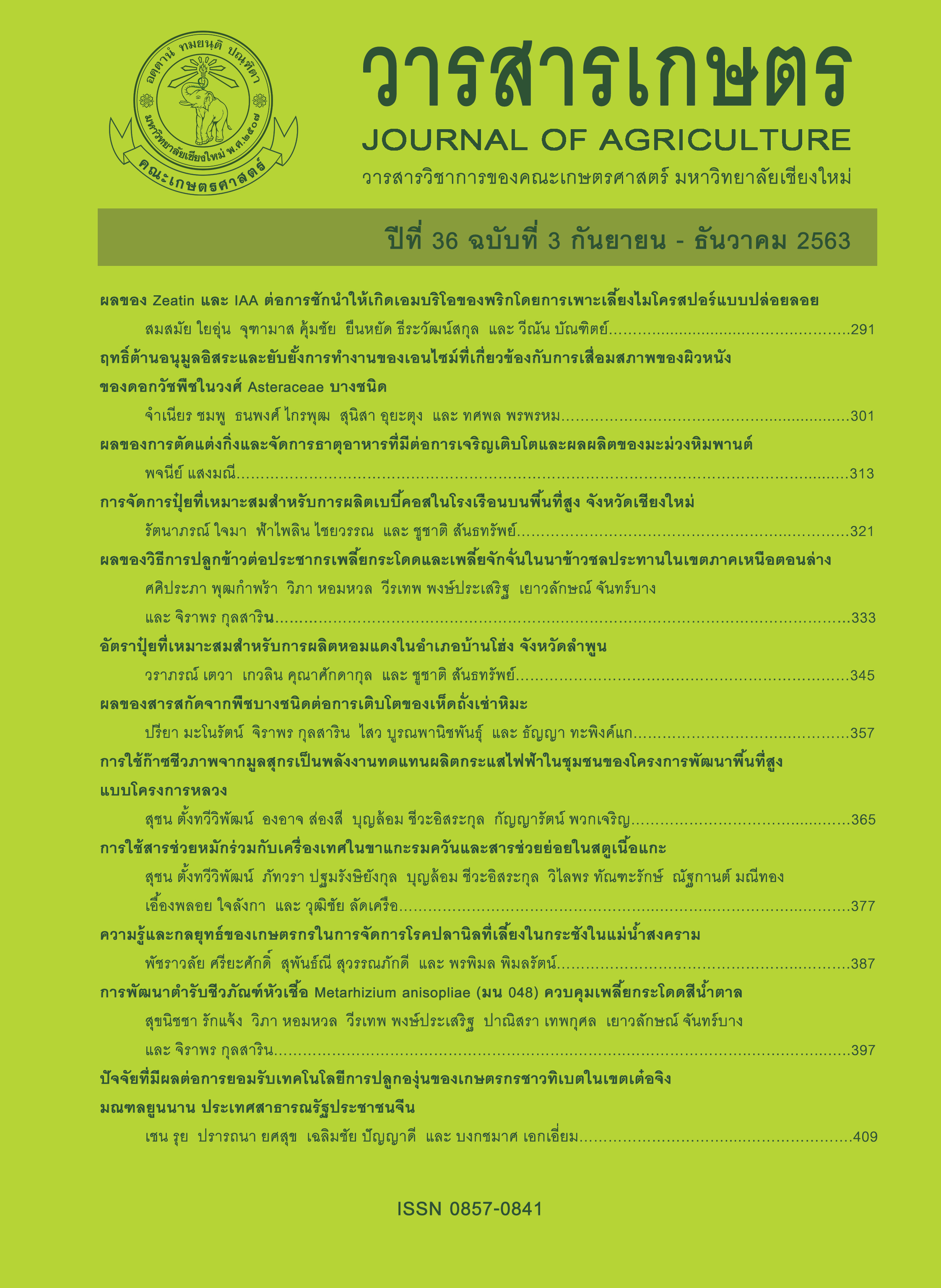การใช้สารช่วยหมักร่วมกับเครื่องเทศในขาแกะรมควัน และสารช่วยย่อยในสตูเนื้อแกะ
Main Article Content
บทคัดย่อ
แกะขนเพศผู้ที่ผ่านการขุนมาแล้วจำนวน 6 ตัว มีอายุเฉลี่ย 14.6 ± 1.9 เดือน มีน้ำหนักตัว 37.1 ± 4.0 กิโลกรัม เมื่อนำไปชำแหละ มีเปอร์เซ็นต์ซากเฉลี่ย (ไม่รวมเครื่องใน) 50.1% ซึ่งประกอบด้วยส่วนซาก 38.8% LW ได้แก่ เนื้อคอ เนื้อไหล่ เนื้ออก ขา สันซี่โครง สันสะเอว และเนื้อสะโพก เมื่อรวมเครื่องในหลังล้างซึ่งมีน้ำหนักเฉลี่ย 12.7% LW แล้ว นับเป็นส่วนที่รับประทานได้เท่ากับ 51.5% LW ในการนำเนื้อส่วนขาแกะทั้งขาหน้าและขาหลังไปรมควันได้ใช้จำนวน 24 ขา น้ำหนักเฉลี่ยขาละ 1.69 กิโลกรัม แบ่งออกเป็น 4 กลุ่ม กลุ่มละ 6 ซ้ำ ใช้น้ำหมักที่ไม่ใส่และใส่เครื่องเทศ รวมทั้งมีสารช่วยหมัก ได้แก่ เกลือ น้ำตาลและโซเดียมอิริทอร์เบต (C6H7NaO6) ระดับต่างกัน 4 สูตร ต้มให้เดือด ทิ้งไว้ให้เย็น ก่อนฉีดเข้าเนื้อขาละประมาณ 1.5 ลิตร นวดแล้วหมักทิ้งไว้ในตู้เย็นข้ามคืน แล้วนำไปรมด้วยควันอ้อยนาน 6 ชั่วโมง จากนั้นนำไปทดสอบการชิมและประเมินทางประสาทสัมผัส (sensory evaluation) ด้วยวิธี 9-point hedonic scale โดยใช้ผู้ประเมิน จำนวน 56 คน ผลปรากฏว่า ขาแกะรมควันสูตรน้ำหมักที่ 3 คือ สูตรที่ใส่เครื่องเทศ มีโซเดียมอิริทอร์เบตระดับ 25 กรัม เกลือ 500 กรัมและน้ำตาล 1,250 กรัม (0.2, 4.0 และ 10.1% ของน้ำหมัก ตามลำดับ) ผู้บริโภคมีความชอบโดยรวมมากที่สุด อยู่ในระดับ “ชอบเล็กน้อย” (คะแนน 6.93 ± 1.13) สูงกว่าสูตรอื่นๆ อย่างมีนัยสำคัญ (P<0.05) รองลงมาเป็นสูตรที่ 4 ซึ่งเป็นน้ำหมักที่ใส่เครื่องเทศเช่นเดียวกัน แต่มีระดับเกลือ 1,000 กรัม (7.8%) สำหรับการทำสตูเนื้อแกะ ได้ใช้เนื้อส่วนสะโพก จำนวน 1.5 กิโลกรัม หั่นเป็นชิ้นสี่เหลี่ยมขนาดเล็กพอดีคำ จำนวน 24 ชิ้น แบ่งเนื้อออกเป็น 3 กลุ่ม กลุ่มละ 3 ซ้ำ หรือรวมทั้งสูตร (กลุ่ม) ประมาณ 500 กรัม นำไปหมักกับสารช่วยย่อย หรือสารช่วยให้เนื้อนุ่ม (tenderizer) ต่างกัน 3 ชนิด ขยำให้เข้ากับเนื้อสะโพก คือ สูตรที่ 1 ใช้สับปะรดสุกปานกลาง 50 กรัม หมัก 15 นาที แล้วแยกเนื้อสับปะรดออก สูตรที่ 2 ใช้เบกกิ้งโซดา 1 ช้อนโต๊ะ หมัก 1 ชั่วโมง และสูตรที่ 3 ใช้เอนไซม์ทางการค้า 1 ช้อนโต๊ะ หมัก 30 นาที จากนั้นนำไปทำเป็นสตู แล้วทดสอบการชิมด้วยวิธี 9-point hedonic scale เช่นเดียวกับขาแกะรมควัน ปรากฏว่า ผู้ชิมชอบสูตรหมักที่ใช้สับปะรดซึ่งมีเอนไซม์โบรมีเลนและมีรสชาติหวานอมเปรี้ยวเล็กน้อยจากน้ำสับปะรดมากกว่าสูตรเบกกิ้งโซดาและเอนไซม์การค้าอย่างมีนัยสำคัญ (P<0.05) โดยมีความชอบโดยรวมอยู่ในระดับ “ปานกลาง” มีค่าคะแนนเท่ากับ 7.20 ± 1.24
Article Details
เอกสารอ้างอิง
Cheva-Isarakul, B. 1998. Production and utilization of wool in the upper northern region of Thailand. Research report. Faculty of Agriculture, Chiang Mai University, Chiang Mai. (in Thai)
Division of Livestock Extension and Development. 2019. Product development from livestock. (Online). Available: http://extension.dld. go.th/th1/index.php?option=com_content& view=category&id=51:2012-03-05-10-26-11&layout=blog&Itemid =84&layout=default (October 1, 2019). (in Thai)
Kirton, A.H., G.J.K. Mercer, D.M. Duganzich, J.N. Clarke and E.G. Woods. 1999. Composition of lamb carcasses and cuts based on the October 1983 to 1998 export lamb carcass classification standards in New Zealand. New Zealand Journal of Agricultural Research 42(1): 65-75.
National Bureau of Agricultural Commodity and Food Standards. 2006. Thai agricultural commodity and food standard TACFS 6004-2006: Sheep meat. National Bureau of Agricultural Commodity and Food Standards, Ministry of Agriculture and Cooperatives, Bangkok. 14 p. (in Thai)
Peryam, D.R. and F.J. Pilgrim. 1957. Hedonic scale method of measuring food preferences. Food Technology 11: 9-14.
Pornchalermpong, P. and N. Rattanapanont. 2018. Chemical composition of meat. (Online). Available: http://www.foodnetworksolution. com/wiki/ word/2803 (September 2, 2018). (in Thai)
Pornchalermpong, P. and N. Rattanapanont. 2020. Sodium erythorbate (E316). (Online). Available: http://www.foodnetworksolution. com/wiki/word/1954/ sodium-erythorbate-e316. (May 20, 2020). (in Thai)
SACICT. 2019. Fleece fabric. (Online). Available: https://www.sacict.or.th/uploads/items/attachments/3d76cc27d29c076b2c374df9ac79d6a8/_20f888d13e9e38c98e65e11700afcd75.pdf (May 10, 2019). (in Thai)
Samaunkid, N. 2005. Meat and Product Technology. Faculty of Agricultural Technology, Songkhla Rajabhat University, Songkhla. 371 p. (in Thai)
Santiparadorn, P. 2020. Toxicity of nitrate and nitrite substances. (Online). Available: https://pharmacy.mahidol.ac.th/th/service-knowledge -article-info.php?id=326 (May 1, 2020). (in Thai)
Steel, R.G.D., J.H. Torrie and D.A. Dickey. 1997. Principles and Procedures of Statistics: A Biometrical Approach. 3rd ed. McGraw-Hill Book Co. Inc., New York. 666 p.
Tangtaweewipat, S., P. Pathomrungsiyounggu, B. Cheva-Isarakul, O. Songsee and N. Maneethong. 2019. Product processing of wool sheep. Research report. Highland Research and Development Institute (Public Organization), Chiang Mai. 79 p. (in Thai)


